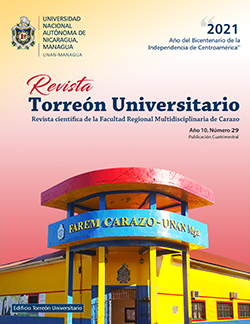Viability of spores of Aspergillus awamori immobilized in cryogels
DOI:
https://doi.org/10.5377/rtu.v10i29.12739Keywords:
Immobilization by entrapment, polivinyl alcoholAbstract
The work consisted of immobilizing Aspergillus awamori spores in polyvinil alcohol (PVA) at different concentrations 10, 12 y 15% (w/v). The viability of the immobilized spores was compared to the free spores, by the conventional plate counting method. The imobilization technique was by entrapment, it consisted of a suspension of spores in the polymer and then it was frozen at -18 ºC for 24 hours. Viability was similar in immobilized and frees pores, this indicates that there are probably no toxic effects of the polymer and that exposure to low temperatures does not damage the structure of the spores. Spores leakage was different in each case of immobilization at 24 hours, the least leakage was with spores at 15% and the highest at 12%. At 96 hours, the lowest was with spores immobilized at 10%, followed by 15% and the highest spores immobilized at 12%, thus remaining until 120 hours.
Downloads
References
Efremenko, E. N., Spiricheva, O. V., Veremeenko, D. V., Baibak, A. V., & Lozinsky, V. I. (2006). L(+)-lactic acid production using poly(vinyl alcohol)-cryogel-entrapped Rhizopus oryzae fungal cells. Journal of Chemical Technology and Biotechnology, 81(4), 519–522. https://doi.org/10.1002/jctb.1524
Efremenko, E., Spiricheva, O., Varfolomeyev, S., & Lozinsky, V. (2006). Rhizopus oryzae fungus cells producing L(+)-lactic acid: Kinetic and metabolic parameters of free and PVA-cryogel-entrapped mycelium. Applied Microbiology and Biotechnology, 72(3), 480–485. https://doi.org/10.1007/s00253-005-0297-y
El-Mansi, E. M. T., Stephanopoulos, G., & Carlson, R. P. (2011). Flux control analysis and stoichiometric network modeling: Basic principles and industrial applications. Fermentation Microbiology and Biotechnology, Third Edition, December 2011, 165–200. https://doi.org/10.1201/b11490-13
Lozinsky, V. I., & Plieva, F. M. (1998). Poly(vinyl alcohol) cryogels employed as matrices for cell immobilization. 3. Overview of recent research and developments. Enzyme and Microbial Technology, 23(3–4), 227–242. https://doi.org/10.1016/S0141-0229(98)00036-2
Plieva, F. M., Galaev, I. Y., Noppe, W., & Mattiasson, B. (2008). Cryogel applications in microbiology. Trends in Microbiology, 16(11), 543–551. https://doi.org/10.1016/j.tim.2008.08.005
Willaert, R. G., & Baron, G. V. (1996). Gel entrapment and micro-encapsulation: Methods, applications and engineering principles. Reviews in Chemical Engineering, 12(1–2), 160–205. https://doi.org/10.1515/revce.1996.12.1-2.1
Published
How to Cite
Issue
Section
License
Copyright (c) 2021 Universidad Nacional Autónoma de Nicaragua, Managua

This work is licensed under a Creative Commons Attribution-NonCommercial-NoDerivatives 4.0 International License.
Los autores que publican en esta revista están de acuerdo con los siguientes términos.
- El autor o los autores de los artículos, ensayos o investigaciones conceden a la Universidad Nacional Autónoma de Nicaragua, Managua (UNAN-Managua) los derechos de edición (copyright) del trabajo enviado, por consiguiente la Universidad cuenta con el derecho exclusivo para publicar el artículo durante el periodo completo de los derechos de autor.
- Estos derechos de autor/ autores autorizan a la Revista Torreón Universitario y a la Universidad editar y divulgar/publicar el artículo en dicha Revista, incluyendo reproducción impresa y electrónica, el almacenamiento, recuperación y cualquier otro tipo de publicación, y fuentes de información secundaria como servicios de resúmenes y bases de datos, así mismo la facultan a proteger el artículo contra el uso no autorizado para su difusión por medios impresos o electrónicos (PDF, HTML, EPUB, XML u otros).
Licencia para el uso del contenido
La revista hace uso de la Licencia Creative Commons Atribución-NoComercial-SinDerivar 4.0 Internacional.
Bajo esta declaración:

Este revista está sujeta a una licencia de Creative Commons Reconocimiento-NoComercial-SinObraDerivada 4.0 Internacional. Puede ser copiada, distribuida y transmitida públicamente siempre y cuando se cite al autor y la fuente (Revista Torreón Universitario), no debe modificarse ni utilizarse con ningún fin comercial. La licencia completa se puede consultar en http://creativecommons.org/licenses/by-nc-nd/4.0/.

